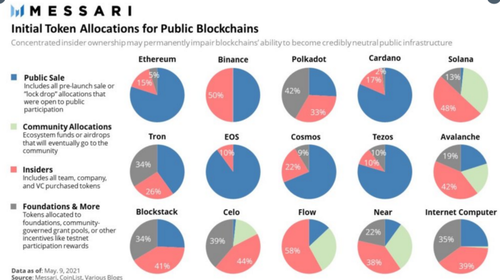Feature your business, services, products, events & news. Submit Website.
Breaking Top Featured Content:
The Case For A Decentralization Premium
Authored by Omid Malekan via Medium.com,
Theodore Roosevelt once observed that nothing in the world is worth doing unless it means effort, difficulty and pain.
True for building the Panama Canal, and true enough for building a Web3 protocol – but only if it’s actually decentralized.
Crypto has been in turmoil lately. Here a prominent stablecoin project failing in the span of a few days, in the spectacular fashion that only an algorithmic coin can. There a slew of once high flying coins crashing down, and their owners wondering if they were the punchline of an inside joke between a founder and a VC. Here yet another bridge being exploited. There some other NFT project being rug pulled.
Most people see these machinations through the lens of price, but price is ephemeral. We’ve seen promising projects decline by 90% before, only to come back stronger. We’ve also seen poseur projects fall by 90%, only to fall another 90% and disappear. Crypto can be thought of as startup equity with the unique twist of having price discovery from the start. Prices fluctuate wildly in the short run because sentiment trumps fundamentals, and many projects don’t have any. But like any other startup, what matters in the long run is whether a project delivers something useful.
Not in terms of transactions per second, clean user interfaces or efficient governance, that’s what Big Banks and Big Tech are for. Crypto projects should be measured by the unique attributes of decentralization, features like trustlessness, censorship-resistance, transparency and — as a direct result — resilience. Given the many downsides of decentralization, these attributes should be priority one for every project. On a long enough timeline, they will determine price.
Bitcoin node distribution via https://bitnodes.io/
Consider the case of Bitcoin. It took a decade to mature and did so gradually. Its network is now decentralized to a fault and may never change, come hell or high energy prices. As frustrating as this obdurateness may be, it makes that network one of the most resilient on earth. That’s why the coin has entered the conversation as a potential reserve currency. The more the rest of the world descends into chaos, the greater the need for an apolitical and algorithmically minted store of value.
Unlike bank accounts, GoFundMe balances or whatever Roubini is working on, Bitcoin is money that you can take into a foxhole — its low throughput and poor UI be damned.
Bitcoin will survive this bear market because it is decentralized. For that reason, it should trade at a premium to almost everything else.
Lune ownership from lunarichlist.com
Now consider the case of Luna and UST. Other algorithmic stablecoins have failed, but none so spectacularly. What made UST special (and dangerous) was the speed with which it grew, rising tenfold in the span of a year and setting the stage for an Icarian fall. It grew quickly because it was centralized. Both the Terra blockchain and its most popular applications were created by one company. Terraform Labs also controlled half the original token supply and used its financial firepower to fund the ill-fated Anchor yield, not to mention the Bitcoin reserve and Curve takeover.
Also contributing to the collapse was the cult of personality around Do Kwon. Luna owners were all too eager to defer to a dictator so long as they were making money. But Kwon was nowhere to be found when the project entered a tailspin, contributing to the loss of trust. Those who claim that UST was the victim of an attack — which it probably was — should remember that the entire point of this technology is to achieve resilience in the face of constant attack. Projects that can’t handle attacks shouldn’t exist.
Terra was not resilient because it took too many shortcuts. Had the team stuck to the original plan of integrating UST into a merchant payment network and focused on organic growth, then its stablecoin may have had a fighting chance. But the founder wanted to be famous and powerful, and the community gave him their support, so things went off the rails. Part of Kwon’s god complex may have stemmed from the fact that his project was very well funded.
Like other decentralization sellouts, Terra had tens of millions of dollars in the bank, from a successful ICO back in 2019 and additional raises since. That money helped fund ecosystem development, which was good, but it also funded a lot of egos, which was fatal.
Biggest ICOs of the last boom
We’ve heard this story before. The short history of crypto is filled with examples of projects that raised a lot of money, sacrificed first principles to steal the limelight, then faltered. The original DAO was hacked. Tezos devolved into a governance crisis almost right away. Block.one thrashed from one pointless endeavor to another, even spending $30m on a domain name. Telegram had to pay civil penalties and give the money back. Basis never launched. Ripple doesn’t do anything, and never has.
On the other stride of the spectrum is Bitcoin, which never raised a penny, took its time to grow, and is now worth half a trillion dollars. Similarly, Ethereum only ever raised $16m — one tenth of the amount raised recently by Tom Brady’s NFT platform — and almost all of it came from the public. Insiders never controlled more than 15% of the token supply, and being Proof of Work diluted them further. It too has been painfully slow to evolve, but is well positioned to survive a bear market. If the merge succeeds and rollups continue to evolve then it can come out more useful than ever.
Solana disdain for the public, via Messari.io
Now consider the case of the latest generation of smart contract platforms like Solana, Avalanche, Polygon, BSC and Fantom. Instead of trying to develop their own communities in an organic fashion, most have focused on siphoning Ethereum’s by adopting the Ethereum Virtual Machine. That strategy makes it easier for users and developers to port over, but also diminishes what made these protocols special in the first place. Being clones, the only way they can distinguish themselves is by increasing capacity via greater centralization. Good for lower transaction fees, bad for why you need a blockchain in the first place.
To make matters worse, most of these platforms have a great deal of insider ownership, the kind you’d expect from a traditional tech company, not a supposedly community-controlled platform.
Like Terra, all of these projects have smart founders and capable teams. If they were more patient, then they could have built something worthwhile — both Bitcoin and Ethereum have their flaws. But billions of dollars worth of locked up tokens will soon hit the market, so shortcuts had to be taken. Adding insult to injury is the fact that the companies that manage these blockchains have raised a lot of money themselves. Ava Labs, the team behind Avalanche, has raised $300m at a $5b valuation. That makes the company half as valuable as the blockchain. How decentralized can any protocol be if so much of the value accrues to the founders?
Avalanche’ primary go-to-market strategy has been to pay users to come over from Ethereum, leading to the risky situation where almost all the tokens on Avalanche are wrapped tokens bridged from elsewhere. Blockchain bridges are honeypots for hackers — as the Solana community learned the hard way. To mitigate such risks, Ava Labs has made its new bridge highly centralized. It has only 4 validators, one of which — surprise, surprise — is Ava Labs itself.
Welcome to the world of decentralization theater, the fastest way for insiders to get rich in crypto, at least on the way up. Impatient crypto investors love chasing the next hot thing, and the market tends to reward projects that abandon first principles for short term gain during bull markets. But the fundamentals — or lack thereof — often lead to a reckoning during the bear.
It’s worth noting that decentralization is no panacea and has many drawbacks. As I argue in my new book, the most likely outcome of the crypto revolution is a hybrid future, one where the core protocols are decentralized but the ramps and interfaces that most users rely on are not. Foundations and corporations will still have important roles to play, and there will be plenty of value creation to go around. But the one thing the market will not tolerate is inauthenticity, particularly at core. The more centralized the blockchain, the less antifragile the community.
Ironically, the greatest tell of whether a project is actually decentralized is how slowly it evolves. That’s why Bitcoin takes years to execute a trivial BIP and Ethereum has had endless delays in its migration to proof of stake. This indicator also applies to dApps that move slowly due to inefficient governance. All solutions that move fast and break things will eventually be broken by market forces.
As frustrating as decentralized progress can be, the market should reward the related coins with a premium.
* * *
I own some Bitcoin and Eth, and this is not investment advice. Crypto winters are not for the faint of heart, and how much any coin is down from it’s all time high is a meaningless number.
Tyler Durden
Mon, 05/30/2022 – 15:40
Continue reading at ZeroHedge.com, Click Here.





